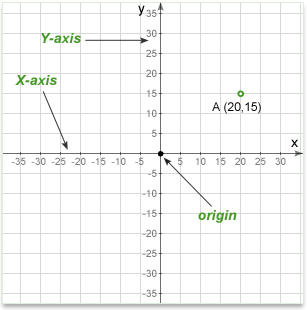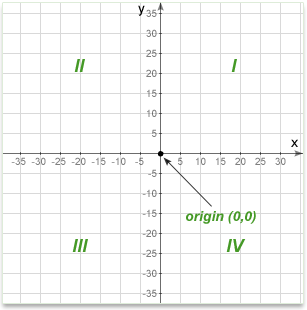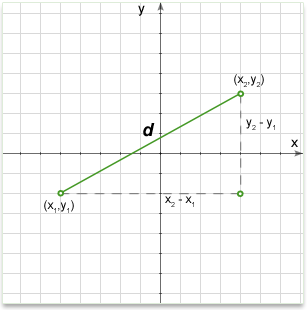
GRE Prep Club Daily Prep
Thank you for using the timer - this advanced tool can estimate your performance and suggest more practice questions. We have subscribed you to Daily Prep Questions via email.
Customized
for You
Track
Your Progress
Practice
Pays
Not interested in getting valuable practice questions and articles delivered to your email? No problem, unsubscribe here.
GRE Quant - Coordinate Geometry Theory
[#permalink]
 Updated on: 03 Sep 2024, 02:20
Updated on: 03 Sep 2024, 02:20
3
Expert Reply
1
Bookmarks
Frequency of the concepts tested: High
Definition
Coordinate geometry, or Cartesian geometry, is the study of geometry using a coordinate system and the principles of algebra and analysis.
The Coordinate Plane
In coordinate geometry, points are placed on the "coordinate plane" as shown below. The coordinate plane is a two-dimensional surface on which we can plot points, lines and curves. It has two scales, called the x-axis and y-axis, at right angles to each other. The plural of axis is 'axes' (pronounced "AXE-ease").

A point's location on the plane is given by two numbers, one that tells where it is on the x-axis and another which tells where it is on the y-axis. Together, they define a single, unique position on the plane. So in the diagram above, the point A has an x value of 20 and a y value of 15. These are the coordinates of the point A, sometimes referred to as its "rectangular coordinates".
X axis
The horizontal scale is called the x-axis and is usually drawn with the zero point in the middle. Values to the right are positive and those to the left are negative.
Y axis
The vertical scale is called the y-axis and is also usually drawn with the zero point in the middle. Values above the origin are positive and those below are negative.
Origin
The point where the two axes cross (at zero on both scales) is called the origin.
Quadrants
When the origin is in the center of the plane, they divide it into four areas called quadrants.

The first quadrant, by convention, is the top right, and then they go around counter-clockwise. In the diagram above they are labeled Quadrant 1, 2 etc. It is conventional to label them with numerals but we talk about them as "first, second, third, and fourth quadrant".
Point (x,y)
The coordinates are written as an "ordered pair". The letter P is simply the name of the point and is used to distinguish it from others.
The two numbers in parentheses are the x and y coordinate of the point. The first number (x) specifies how far along the x (horizontal) axis the point is. The second is the y coordinate and specifies how far up or down the y axis to go. It is called an ordered pair because the order of the two numbers matters - the first is always the x (horizontal) coordinate.
The sign of the coordinate is important. A positive number means to go to the right (x) or up (y). Negative numbers mean to go left (x) or down (y).
Distance between two points
Given coordinates of two points, distance D between two points is given by:
\(D=\sqrt{dx^2+dy^2}\) (where \(dx\) is the difference between the x-coordinates and \(dy\) is the difference between the y-coordinates of the points)

As you can see, the distance formula on the plane is derived from the Pythagorean theorem.
Above formula can be written in the following way for given two points \((x_1,y_1)\) and \((x_2,y_2)\):
\(D=\sqrt{(x_2-x_1)^2+(y_2-y_1)^2}\)
Vertical and horizontal lines
If the line segment is exactly vertical or horizontal, the formula above will still work fine, but there is an easier way. For a horizontal line, its length is the difference between the x-coordinates. For a vertical line its length is the difference between the y-coordinates.
Distance between the point A (x,y) and the origin
As the one point is origin with coordinate O (0,0) the formula can be simplified to:
\(D=\sqrt{x^2+y^2}\)
Example #1
Q: Find the distance between the point A (3,-1) and B (-1,2)
Solution: Substituting values in the equation we'll get
\(D=\sqrt{(x_2-x_1)^2+(y_2-y_1)^2}\)
\(D=\sqrt{(-1-3)^2+(2-(-1))^2}=\sqrt{16+9}=5\)
Midpoint of a Line Segment
A line segment on the coordinate plane is defined by two endpoints whose coordinates are known. The midpoint of this line is exactly halfway between these endpoints and it's location can be found using the Midpoint Theorem, which states:
• The x-coordinate of the midpoint is the average of the x-coordinates of the two endpoints.
• Likewise, the y-coordinate is the average of the y-coordinates of the endpoints.

Coordinates of the midpoint \(M (x_m,y_m)\) of the line segment AB, (\(A (x_1,y_1)\) and \(B (x_2,y_2)\)) are \(x_m=\frac{x_1+x_2}{2}\) and \(y_m=\frac{y_1+y_2}{2}\)
Coordinate geometry, or Cartesian geometry, is the study of geometry using a coordinate system and the principles of algebra and analysis.
The Coordinate Plane
In coordinate geometry, points are placed on the "coordinate plane" as shown below. The coordinate plane is a two-dimensional surface on which we can plot points, lines and curves. It has two scales, called the x-axis and y-axis, at right angles to each other. The plural of axis is 'axes' (pronounced "AXE-ease").
A point's location on the plane is given by two numbers, one that tells where it is on the x-axis and another which tells where it is on the y-axis. Together, they define a single, unique position on the plane. So in the diagram above, the point A has an x value of 20 and a y value of 15. These are the coordinates of the point A, sometimes referred to as its "rectangular coordinates".
X axis
The horizontal scale is called the x-axis and is usually drawn with the zero point in the middle. Values to the right are positive and those to the left are negative.
Y axis
The vertical scale is called the y-axis and is also usually drawn with the zero point in the middle. Values above the origin are positive and those below are negative.
Origin
The point where the two axes cross (at zero on both scales) is called the origin.
Quadrants
When the origin is in the center of the plane, they divide it into four areas called quadrants.
The first quadrant, by convention, is the top right, and then they go around counter-clockwise. In the diagram above they are labeled Quadrant 1, 2 etc. It is conventional to label them with numerals but we talk about them as "first, second, third, and fourth quadrant".
Point (x,y)
The coordinates are written as an "ordered pair". The letter P is simply the name of the point and is used to distinguish it from others.
The two numbers in parentheses are the x and y coordinate of the point. The first number (x) specifies how far along the x (horizontal) axis the point is. The second is the y coordinate and specifies how far up or down the y axis to go. It is called an ordered pair because the order of the two numbers matters - the first is always the x (horizontal) coordinate.
The sign of the coordinate is important. A positive number means to go to the right (x) or up (y). Negative numbers mean to go left (x) or down (y).
Distance between two points
Given coordinates of two points, distance D between two points is given by:
\(D=\sqrt{dx^2+dy^2}\) (where \(dx\) is the difference between the x-coordinates and \(dy\) is the difference between the y-coordinates of the points)
As you can see, the distance formula on the plane is derived from the Pythagorean theorem.
Above formula can be written in the following way for given two points \((x_1,y_1)\) and \((x_2,y_2)\):
\(D=\sqrt{(x_2-x_1)^2+(y_2-y_1)^2}\)
Vertical and horizontal lines
If the line segment is exactly vertical or horizontal, the formula above will still work fine, but there is an easier way. For a horizontal line, its length is the difference between the x-coordinates. For a vertical line its length is the difference between the y-coordinates.
Distance between the point A (x,y) and the origin
As the one point is origin with coordinate O (0,0) the formula can be simplified to:
\(D=\sqrt{x^2+y^2}\)
Example #1
Q: Find the distance between the point A (3,-1) and B (-1,2)
Solution: Substituting values in the equation we'll get
\(D=\sqrt{(x_2-x_1)^2+(y_2-y_1)^2}\)
\(D=\sqrt{(-1-3)^2+(2-(-1))^2}=\sqrt{16+9}=5\)
Midpoint of a Line Segment
A line segment on the coordinate plane is defined by two endpoints whose coordinates are known. The midpoint of this line is exactly halfway between these endpoints and it's location can be found using the Midpoint Theorem, which states:
• The x-coordinate of the midpoint is the average of the x-coordinates of the two endpoints.
• Likewise, the y-coordinate is the average of the y-coordinates of the endpoints.
Coordinates of the midpoint \(M (x_m,y_m)\) of the line segment AB, (\(A (x_1,y_1)\) and \(B (x_2,y_2)\)) are \(x_m=\frac{x_1+x_2}{2}\) and \(y_m=\frac{y_1+y_2}{2}\)
Re: GRE Quant - Coordinate Geometry Theory
[#permalink]
 11 Jul 2020, 11:09
11 Jul 2020, 11:09
1
Expert Reply
1
Bookmarks
Coordinate Geometry Questions by Tag
Quantitative Comparison Questions
Multiple-choice Questions — Select One Answer Choice
Multiple-choice Questions — Select One or More Answer Choices
Numeric Entry Question
Data Interpretation Sets
HARD QuestionsMEDIUM QuestionsEASY Questions



